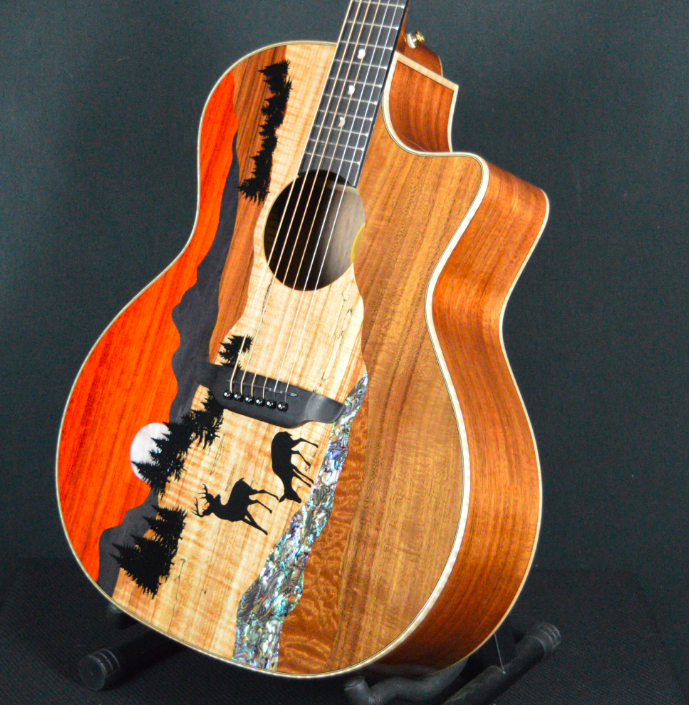
Luna Guitars
TO RIVAL OTHER BRANDS?
It feels like every guitarist must remember the first moment of holding a guitar. How did the body of it mold onto yours? Did the frets feel sharp or was it cleanly shaved down? There are memories here embedded in the guitarist- in fact, I’m more than sure that this is true for every musician. The pianist and drummer could concur.
The first guitar I remember buying was the Luna Guitars’ Passionflower Acoustic-Electric Guitar. It was a maple build with a Preamp: Orion 4-Band EQ w/ Digital Tuner; its neck was a Mahogany/Rosewood with Luna’s iconic Mother-of-pearl Inlaid Moon Phase Fret Markers with a purple body. A flower surrounded the soundhole cut-out. I was so memorized when I saw it, it looked like a drawing I once painted had come to life! It begged for me to play it, and so I took it home.
Luna Guitars have been around since 2005 and was founded by stain-glass artist Yvonne de Villiers. According to Armadilloent de Villiers inspiration came from watching her mother’s struggle over her 40-year bass guitar career. She sought instruments that could be uniquely tailored to fit different players’ bodies, hands, and musical styles. She also wished to avoid the same boring look that most guitars had, but rather making the instruments look and feel radical.
Today you can find Luna guitars everywhere! From Sweetwater to Sam Ash, from Reverb to Guitar Center. I frankly find it crazy that Fender (founded 1946), Taylor (founded 1974), and Yamaha (founded 1887) guitars can all be sold at the same in-store level as a Luna can with them only being 16 years of age! However, just because Luna lacks the age that other companies have, they make up the difference with the quality of a $1,000 instrument without breaking the bank.
To make this comparison using Sweetwater, I chose Sunburst-themed guitars from Yamaha, Fender, Taylor, and of course Luna. My only requirements? They had to be in the Sunburst theme, electric-acoustic, was a six-string, and its neck build had to be mahogany for consistency.
The Yamaha was a CPX1200II
6-string Acoustic-electric Guitar, with Spruce Top Rosewood Back and Sides, Mahogany Neck, Ebony Fingerboard, and SRT/System63 Electronics – Vintage Sunburst. For $1,349.99 you can get 3-band EQ, Focus/Wide control, Resonance control, and Blend control. It definitely thrives off bottoms and lower tones audio-wise, but is it worth the money?
Fender granddaddy Newporter
6-string Acoustic-electric Guitar with Spruce Top, Mahogany Back and Sides, Mahogany Neck, Walnut Fingerboard, and Fishman Electronics – Sunburst. Pay $429.99 for a very balanced guitar for players at any stage of the musical journey, especially for those players hanging around with the mid-sounds. The Fishman pickup/preamp is a personal favorite of mine for accentuating the guitar’s natural timbre.
Taylor’s 714-ce V-class
6-string Acoustic-Electric Guitar with Lutz Spruce Top, Indian Rosewood Back and Sides, Mahogany Neck, Ebony Fingerboard, and Taylor ES2 Electronics – Western Sunburst, takes the cake at $3,199.00. It definitely balanced the high-mid-lows better than the other guitars mentioned.
While I could go into a more detailed review on each of these, does the Luna stack up to the massiveness that Yamaha, Fender, and Taylor have? Well, Yes! Definitely! Luna has definitely amassed a dedicated army of fans. If we look into Luna Safari – 6-string Acoustic-electric Guitar with Spruce Top, Mahogany Back and Sides, Mahogany Neck, Walnut Fingerboard, and Luna SL3 Electronics – Tobacco Sunburst Satin. While it lacks the built-in Fishman pickup/preamp or resonance control it makes up with an effortless grab-and-go travel ability. It did sound a bit tin-like on the higher end but for $199.00 for a premium feel – it definitely could be a contender for the next acoustic-electric you pick up.
For a woman-founded company to compete with musical giants, it is an inspiration for other ladies to lead their own companies alongside Luna. As for me? Maybe it’s the nostalgia talking, but my Luna is the best-sounding guitar for me.
Sources:
- https://www.sweetwater.com/store/detail/SafTribalETSB–luna-safari-tribal-travel-guitar-with-preamp-tobacco-sunburst-satin
- https://www.sweetwater.com/store/detail/714ceWSBVCl–taylor-714ce-v-class-grand-auditorium-cutaway-western-sunburst-lutz-spruce-top
- https://www.sweetwater.com/store/detail/CPX1200IIVS–yamaha-cpx1200ii-acoustic-electric-guitar-vintage-sunburst
- https://www.lunaguitars.com/faq_where_made.php
- https://www.armadilloent.com/luna.html